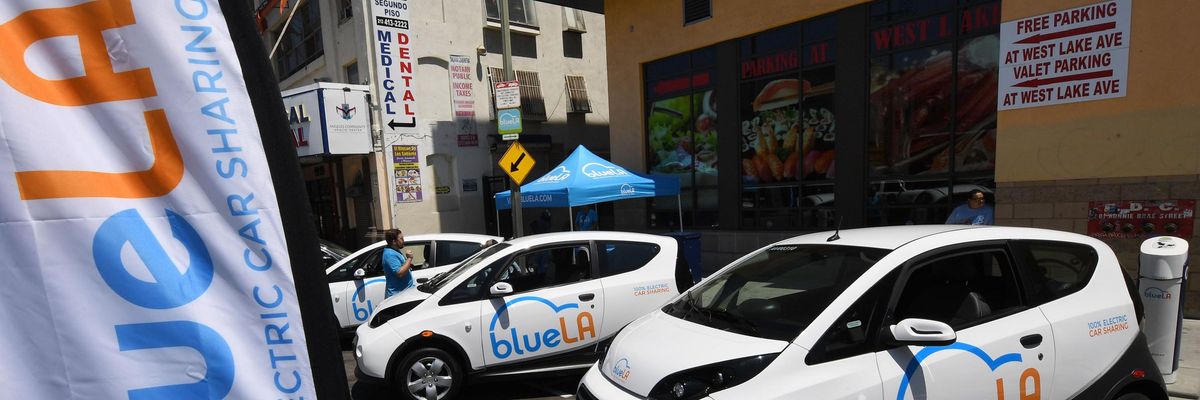
A pay and charging station for what is being billed as the nation's largest 'Electric Vehicle' (EV) car sharing program for disadvantaged communities was unveiled by Los Angeles Mayor Eric Garcetti in Los Angeles on June 9, 2017. (Photo: Mark Ralston/AFP via Getty Images)
Is California Backsliding on Its Plan to Reach Zero Carbon Emissions by Mid-Century?
In reality, California does not actually have a detailed roadmap for slashing greenhouse gas emissions in order to fulfill the Paris Agreement goal of limiting global warming to 1.5 degrees Celsius above preindustrial levels.
California is one of the world's largest economies. It is also a liberal state that acts as a leader in efforts to combat the climate crisis. Indeed, California is said to have revolutionized climate policy, advancing many key pieces of climate legislation that seek to combat global warming and its catastrophic effects. Among them is a plan to ban the sale of new gasoline-powered vehicles statewide by 2035. California leaders also pride themselves in seeking to meet climate goals while maximizing jobs and economic growth.
The irony behind California's efforts to tackle the climate crisis by reducing carbon emissions and eventually attain carbon neutrality by mid-century is that there is a detailed pathway available for the state and for immediate implementation.
The passage of climate bill AB 32, the Global Warming Solutions Act of 2006, set the stage for the state's transition to an ecologically sustainable future. It was a bipartisan clean energy action requiring the Air Resources Board to develop regulations and market mechanisms to reduce the state's greenhouse gas emissions to their 1990 levels by 2020. The state met the goal of AB-32 four years ahead of schedule. In 2016, California's legislature voted to extend the state's climate change targets. SB-32 set a goal of reducing greenhouse gas emission levels by 2030 to 40 percent of 1990 levels, while in 2018 an Executive Order was signed requiring state agencies to reach carbon neutrality by 2045.
California's emissions reduction program has a number of key features, which include the development of California's Climate Scoping Plan and a cap-and-trade program.
In reality, California does not actually have a detailed roadmap for slashing greenhouse gas emissions in order to fulfill the Paris Agreement goal of limiting global warming to 1.5 degrees Celsius above preindustrial levels. For instance, while transportation is the largest source of greenhouse gas emissions in California, the state lacks an identifiable path to decarbonize the sector. Worse still, the state's legally mandated emissions goals do not go beyond 2030. And when a new bill, the Climate Crisis Act (AB 1395), co-authored by Assembly members Al Muratsuchi and Cristina Garcia, was introduced on the last day of last year's legislative session, it was soundly defeated.
AB 1395 went down in defeat at the hands of various organized interest groups, ranging from the oil industry, labor, California Chamber Commerce, and agricultural groups. This was a devastating blow to progressive lawmakers and climate activists who had hoped for the passing of a bill that would ensure the attainment of a carbon-neutral future for the state of California by mid-century.
Among labor groups that strongly opposed AB 1395 was the State Building and Construction Trades Council, AFL-CIO, which represents nearly half a million workers. The organization opposed the bill on the basis of the argument that a reduction target of 90 percent of carbon emissions would cripple investment and innovation. In the same context, in a letter to the Chair of the Senate Appropriations Committee, the Deputy Legislative Director of State Building and Construction Trade Council urged California lawmakers to embrace carbon capture and storage (CCS) technologies as a strategy to mitigating climate change.
Unions representing fossil fuel workers also opposed AB 1395, but it is uncertain whether this was simply due to the fact that the bill did not include a just transition program. Unions representing fossil fuel workers also happen to be in support of CCS strategies as well as expanding oil and gas infrastructure. Assembly member Muratsuchi had another bill on just transition for fossil fuel industry employees last year, AB 1453, but it was held in Assembly Appropriations Committee.
AB 1395 may not, however, be entirely dead. It is still eligible to move and Assembly member Muratsuchi and some of his associates will be talking with stakeholders later this year, according to Ashley Labar, Chief of Staff at California State Assembly. But judging from the way organized interests mobilized in opposition to AB 1395, it is highly doubtful that the bill's fate will be reversed.
The irony behind California's efforts to tackle the climate crisis by reducing carbon emissions and eventually attain carbon neutrality by mid-century is that there is a detailed pathway available for the state and for immediate implementation. It was produced in the summer of 2021 by a group of researchers headed by Robert Pollin at the renowned Political Economy Research Institute (PERI) at the University of Massachusetts-Amherst, and has already received the endorsement of over 20 unions, including three fossil fuel unions. It is a study that demonstrates that California can reach zero emissions by 2045 while also experiencing economic growth, including the creation of over 1 million new jobs statewide through investment programs in energy efficiency, public infrastructure, land restoration and agriculture. The study also includes a robust just transition program, which is absolutely essential since fossil fuel workers will not give up easily what they have managed to secure for themselves (relatively high-paying union jobs with benefits) after many years of hard work.
An Urgent Message From Our Co-Founder
Dear Common Dreams reader, The U.S. is on a fast track to authoritarianism like nothing I've ever seen. Meanwhile, corporate news outlets are utterly capitulating to Trump, twisting their coverage to avoid drawing his ire while lining up to stuff cash in his pockets. That's why I believe that Common Dreams is doing the best and most consequential reporting that we've ever done. Our small but mighty team is a progressive reporting powerhouse, covering the news every day that the corporate media never will. Our mission has always been simple: To inform. To inspire. And to ignite change for the common good. Now here's the key piece that I want all our readers to understand: None of this would be possible without your financial support. That's not just some fundraising cliche. It's the absolute and literal truth. We don't accept corporate advertising and never will. We don't have a paywall because we don't think people should be blocked from critical news based on their ability to pay. Everything we do is funded by the donations of readers like you. Will you donate now to help power the nonprofit, independent reporting of Common Dreams? Thank you for being a vital member of our community. Together, we can keep independent journalism alive when it’s needed most. - Craig Brown, Co-founder |
California is one of the world's largest economies. It is also a liberal state that acts as a leader in efforts to combat the climate crisis. Indeed, California is said to have revolutionized climate policy, advancing many key pieces of climate legislation that seek to combat global warming and its catastrophic effects. Among them is a plan to ban the sale of new gasoline-powered vehicles statewide by 2035. California leaders also pride themselves in seeking to meet climate goals while maximizing jobs and economic growth.
The irony behind California's efforts to tackle the climate crisis by reducing carbon emissions and eventually attain carbon neutrality by mid-century is that there is a detailed pathway available for the state and for immediate implementation.
The passage of climate bill AB 32, the Global Warming Solutions Act of 2006, set the stage for the state's transition to an ecologically sustainable future. It was a bipartisan clean energy action requiring the Air Resources Board to develop regulations and market mechanisms to reduce the state's greenhouse gas emissions to their 1990 levels by 2020. The state met the goal of AB-32 four years ahead of schedule. In 2016, California's legislature voted to extend the state's climate change targets. SB-32 set a goal of reducing greenhouse gas emission levels by 2030 to 40 percent of 1990 levels, while in 2018 an Executive Order was signed requiring state agencies to reach carbon neutrality by 2045.
California's emissions reduction program has a number of key features, which include the development of California's Climate Scoping Plan and a cap-and-trade program.
In reality, California does not actually have a detailed roadmap for slashing greenhouse gas emissions in order to fulfill the Paris Agreement goal of limiting global warming to 1.5 degrees Celsius above preindustrial levels. For instance, while transportation is the largest source of greenhouse gas emissions in California, the state lacks an identifiable path to decarbonize the sector. Worse still, the state's legally mandated emissions goals do not go beyond 2030. And when a new bill, the Climate Crisis Act (AB 1395), co-authored by Assembly members Al Muratsuchi and Cristina Garcia, was introduced on the last day of last year's legislative session, it was soundly defeated.
AB 1395 went down in defeat at the hands of various organized interest groups, ranging from the oil industry, labor, California Chamber Commerce, and agricultural groups. This was a devastating blow to progressive lawmakers and climate activists who had hoped for the passing of a bill that would ensure the attainment of a carbon-neutral future for the state of California by mid-century.
Among labor groups that strongly opposed AB 1395 was the State Building and Construction Trades Council, AFL-CIO, which represents nearly half a million workers. The organization opposed the bill on the basis of the argument that a reduction target of 90 percent of carbon emissions would cripple investment and innovation. In the same context, in a letter to the Chair of the Senate Appropriations Committee, the Deputy Legislative Director of State Building and Construction Trade Council urged California lawmakers to embrace carbon capture and storage (CCS) technologies as a strategy to mitigating climate change.
Unions representing fossil fuel workers also opposed AB 1395, but it is uncertain whether this was simply due to the fact that the bill did not include a just transition program. Unions representing fossil fuel workers also happen to be in support of CCS strategies as well as expanding oil and gas infrastructure. Assembly member Muratsuchi had another bill on just transition for fossil fuel industry employees last year, AB 1453, but it was held in Assembly Appropriations Committee.
AB 1395 may not, however, be entirely dead. It is still eligible to move and Assembly member Muratsuchi and some of his associates will be talking with stakeholders later this year, according to Ashley Labar, Chief of Staff at California State Assembly. But judging from the way organized interests mobilized in opposition to AB 1395, it is highly doubtful that the bill's fate will be reversed.
The irony behind California's efforts to tackle the climate crisis by reducing carbon emissions and eventually attain carbon neutrality by mid-century is that there is a detailed pathway available for the state and for immediate implementation. It was produced in the summer of 2021 by a group of researchers headed by Robert Pollin at the renowned Political Economy Research Institute (PERI) at the University of Massachusetts-Amherst, and has already received the endorsement of over 20 unions, including three fossil fuel unions. It is a study that demonstrates that California can reach zero emissions by 2045 while also experiencing economic growth, including the creation of over 1 million new jobs statewide through investment programs in energy efficiency, public infrastructure, land restoration and agriculture. The study also includes a robust just transition program, which is absolutely essential since fossil fuel workers will not give up easily what they have managed to secure for themselves (relatively high-paying union jobs with benefits) after many years of hard work.
California is one of the world's largest economies. It is also a liberal state that acts as a leader in efforts to combat the climate crisis. Indeed, California is said to have revolutionized climate policy, advancing many key pieces of climate legislation that seek to combat global warming and its catastrophic effects. Among them is a plan to ban the sale of new gasoline-powered vehicles statewide by 2035. California leaders also pride themselves in seeking to meet climate goals while maximizing jobs and economic growth.
The irony behind California's efforts to tackle the climate crisis by reducing carbon emissions and eventually attain carbon neutrality by mid-century is that there is a detailed pathway available for the state and for immediate implementation.
The passage of climate bill AB 32, the Global Warming Solutions Act of 2006, set the stage for the state's transition to an ecologically sustainable future. It was a bipartisan clean energy action requiring the Air Resources Board to develop regulations and market mechanisms to reduce the state's greenhouse gas emissions to their 1990 levels by 2020. The state met the goal of AB-32 four years ahead of schedule. In 2016, California's legislature voted to extend the state's climate change targets. SB-32 set a goal of reducing greenhouse gas emission levels by 2030 to 40 percent of 1990 levels, while in 2018 an Executive Order was signed requiring state agencies to reach carbon neutrality by 2045.
California's emissions reduction program has a number of key features, which include the development of California's Climate Scoping Plan and a cap-and-trade program.
In reality, California does not actually have a detailed roadmap for slashing greenhouse gas emissions in order to fulfill the Paris Agreement goal of limiting global warming to 1.5 degrees Celsius above preindustrial levels. For instance, while transportation is the largest source of greenhouse gas emissions in California, the state lacks an identifiable path to decarbonize the sector. Worse still, the state's legally mandated emissions goals do not go beyond 2030. And when a new bill, the Climate Crisis Act (AB 1395), co-authored by Assembly members Al Muratsuchi and Cristina Garcia, was introduced on the last day of last year's legislative session, it was soundly defeated.
AB 1395 went down in defeat at the hands of various organized interest groups, ranging from the oil industry, labor, California Chamber Commerce, and agricultural groups. This was a devastating blow to progressive lawmakers and climate activists who had hoped for the passing of a bill that would ensure the attainment of a carbon-neutral future for the state of California by mid-century.
Among labor groups that strongly opposed AB 1395 was the State Building and Construction Trades Council, AFL-CIO, which represents nearly half a million workers. The organization opposed the bill on the basis of the argument that a reduction target of 90 percent of carbon emissions would cripple investment and innovation. In the same context, in a letter to the Chair of the Senate Appropriations Committee, the Deputy Legislative Director of State Building and Construction Trade Council urged California lawmakers to embrace carbon capture and storage (CCS) technologies as a strategy to mitigating climate change.
Unions representing fossil fuel workers also opposed AB 1395, but it is uncertain whether this was simply due to the fact that the bill did not include a just transition program. Unions representing fossil fuel workers also happen to be in support of CCS strategies as well as expanding oil and gas infrastructure. Assembly member Muratsuchi had another bill on just transition for fossil fuel industry employees last year, AB 1453, but it was held in Assembly Appropriations Committee.
AB 1395 may not, however, be entirely dead. It is still eligible to move and Assembly member Muratsuchi and some of his associates will be talking with stakeholders later this year, according to Ashley Labar, Chief of Staff at California State Assembly. But judging from the way organized interests mobilized in opposition to AB 1395, it is highly doubtful that the bill's fate will be reversed.
The irony behind California's efforts to tackle the climate crisis by reducing carbon emissions and eventually attain carbon neutrality by mid-century is that there is a detailed pathway available for the state and for immediate implementation. It was produced in the summer of 2021 by a group of researchers headed by Robert Pollin at the renowned Political Economy Research Institute (PERI) at the University of Massachusetts-Amherst, and has already received the endorsement of over 20 unions, including three fossil fuel unions. It is a study that demonstrates that California can reach zero emissions by 2045 while also experiencing economic growth, including the creation of over 1 million new jobs statewide through investment programs in energy efficiency, public infrastructure, land restoration and agriculture. The study also includes a robust just transition program, which is absolutely essential since fossil fuel workers will not give up easily what they have managed to secure for themselves (relatively high-paying union jobs with benefits) after many years of hard work.

